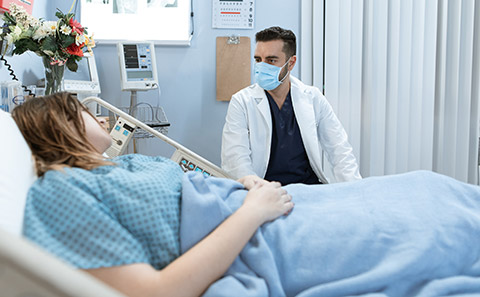Getting the right staffing mix helps reduce hospital deaths

A new study by the University of Southampton has found that health managers should consider the levels of a range of staff, beyond just doctors and nurses, when assessing patient safety.
Research by the University’s School of Heath Sciences shows hospitals with higher levels of allied healthcare professional (AHP) staff, such as physiotherapists, radiographers, dieticians and occupational therapists, report significantly lower mortality rates.
The findings of this analysis of national hospital data in England are published in the journal BMJ Open.
The researchers accessed publicly available data on staffing levels from all NHS staff groups – measured as the ratio of occupied beds to staff numbers. They also looked at data on hospital characteristics and patient deaths. By linking all these different data sources (between 2015 and 2019) the team examined the association between staffing levels of multiple staff groups and the risk of patients dying for 138 general acute care NHS Trusts.
The findings showed that for hospitals where doctors and allied health professionals had to cover fewer beds, there were significantly lower mortality rates. However, for hospitals where there were more healthcare assistants and assistants to allied health professionals in the staffing mix, there were higher mortality rates.
Co-author, Dr Chiara Dall’Ora, comments: “Finding that in some staffing scenarios having more support staff was associated with higher mortality made us reflect. One possible reason may be that this alters the work of other staff groups – for example, adding more healthcare assistants might mean that registered nurses spend more time supervising them. Whatever the reason, it does tell us that getting the right balance of nurses, doctors, allied health professionals and other support staff on wards is crucial to patient safety.”
The study also showed that for each additional bed a doctor was responsible for, the patient risk of death increased by 4 percent. This figure was the same for each additional bed that was added to an allied health professionals’ workload. However, for each additional bed a registered nurse had to cope with, the patient risk of death increased by 7 percent. This figure for nurses was not proven statistically significant in this study, but along with evidence from previous research, it does suggest that higher levels of registered nurses per bed are associated with lower mortality.
Study lead, Professor Peter Griffiths added: “At a time when the NHS is facing critical staff shortages, our study shows potentially very significant consequences of shortages of allied health professionals – given the crucial role they play treating patients – as well as the widely publicised shortages of doctors and nurses.
“We hope that our findings will create an appetite for other studies that are willing to explore the impact of many staffing groups simultaneously, using more detailed data. Our sample, while comprising of the majority of NHS Trusts, allowed us to explore relationships at the hospital level only. This misses the staffing and outcome variation at the ward level which is likely to be equally important. We are keen to explore the availability and usability of routinely collected data at this more granular level from staff groups other than nursing to advance this important research agenda.”
Dr Chiara Dall’Ora adds: “While this is the first study to shine a light on the importance of multi-disciplinary staffing, we hope that it will initiate dialogue on ensuring there are safe staffing levels for all the different groups of staff alike, at policy and workforce planning level.”